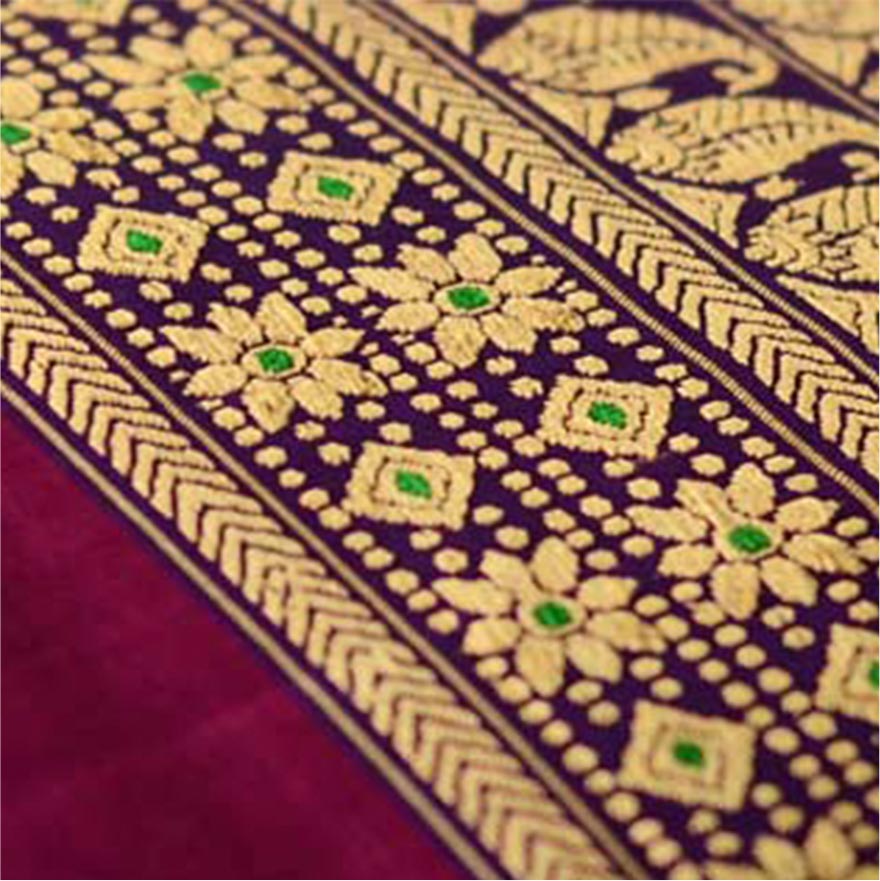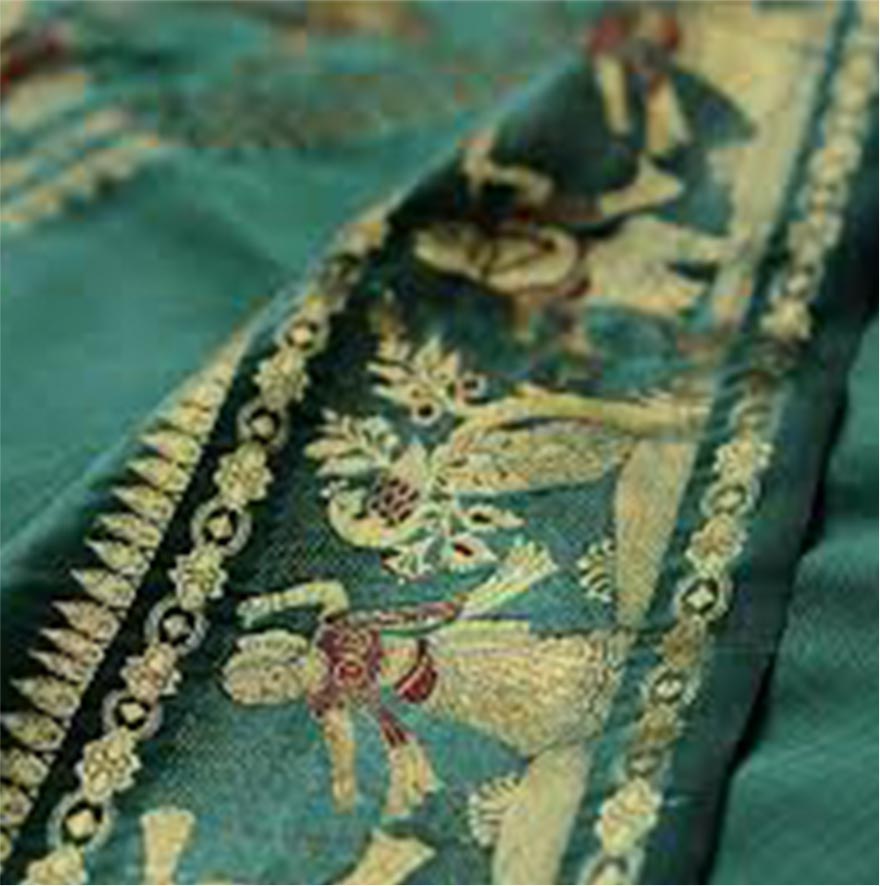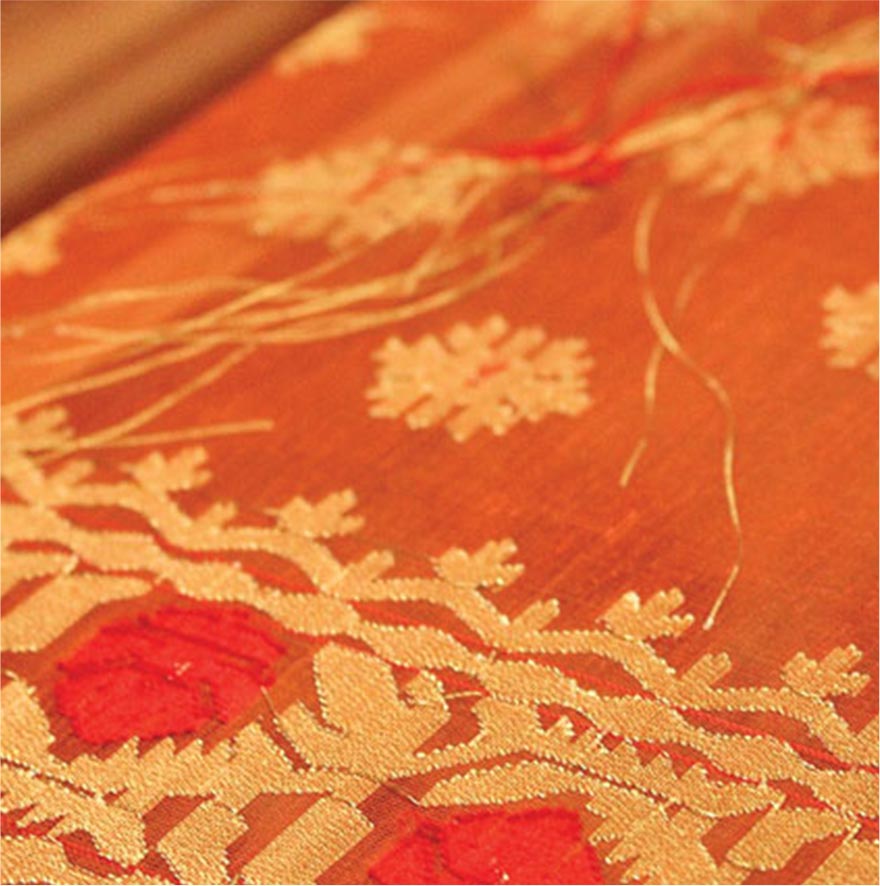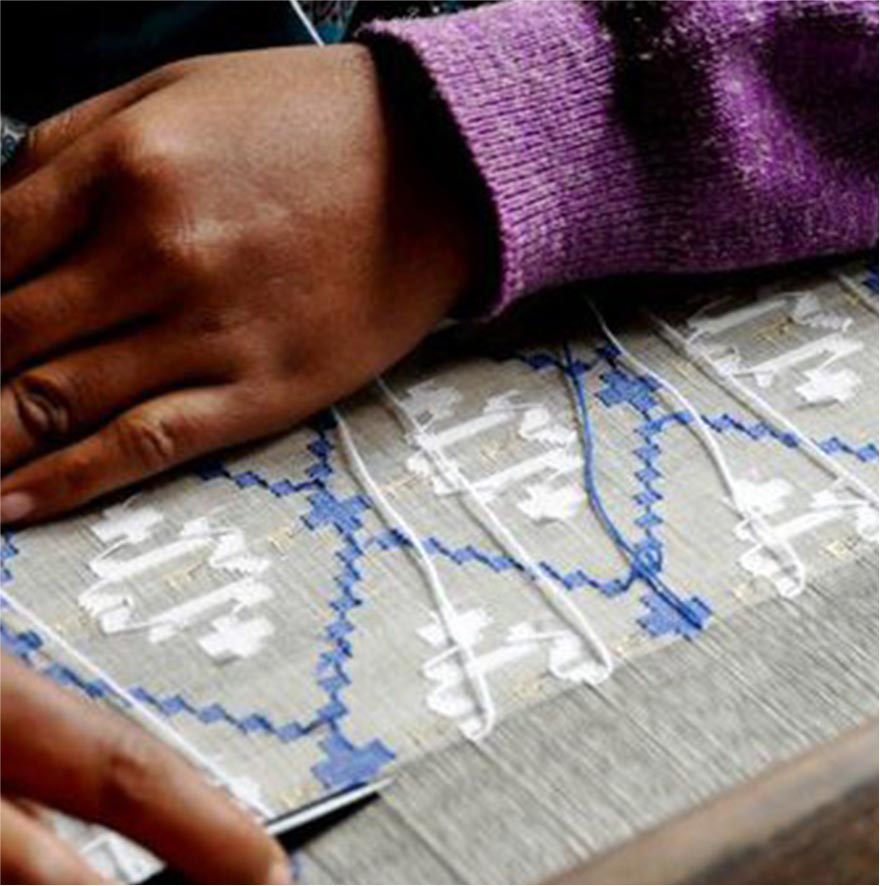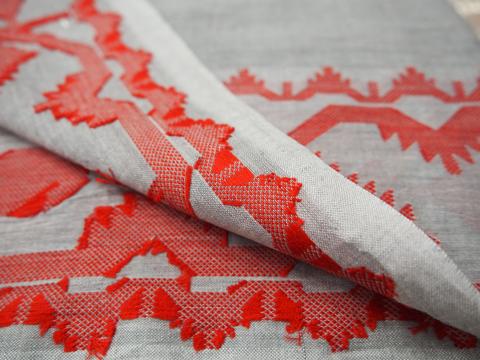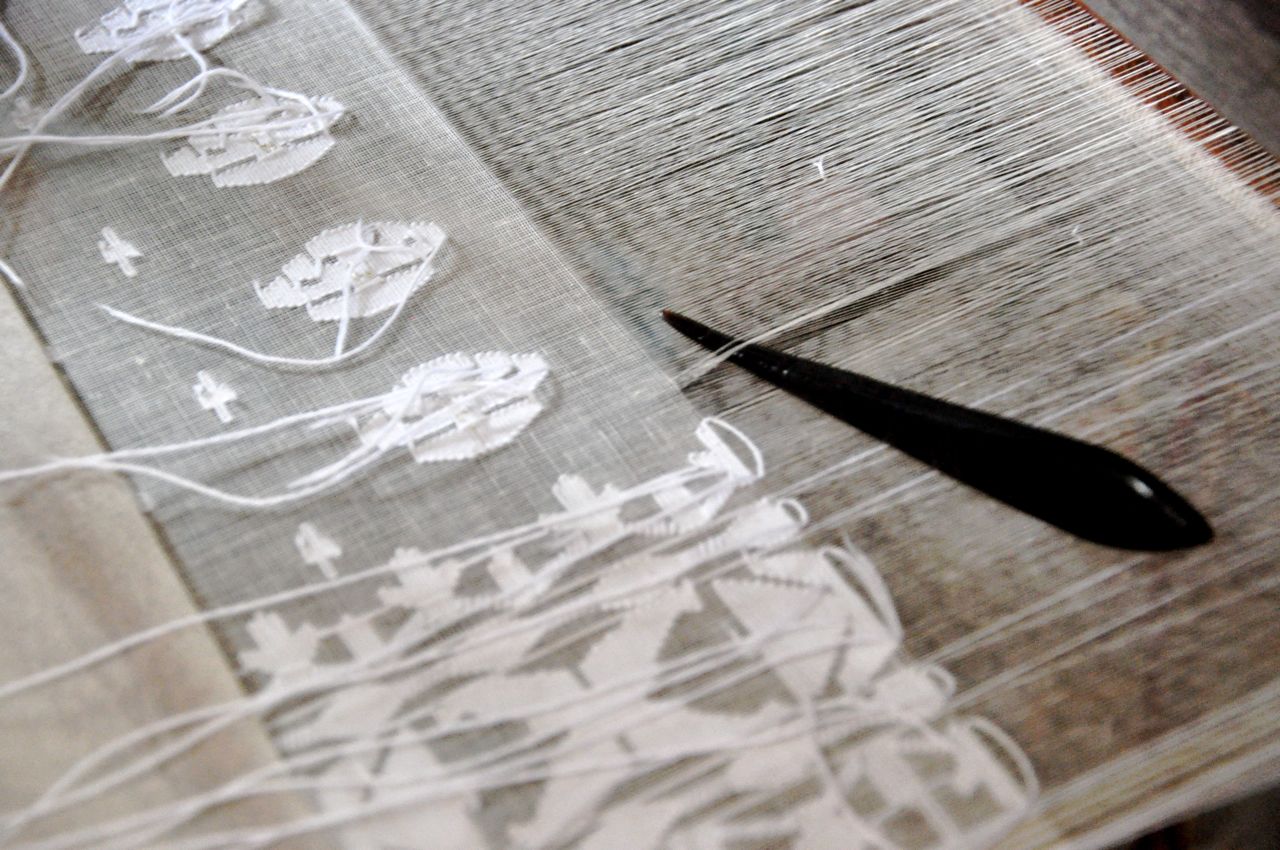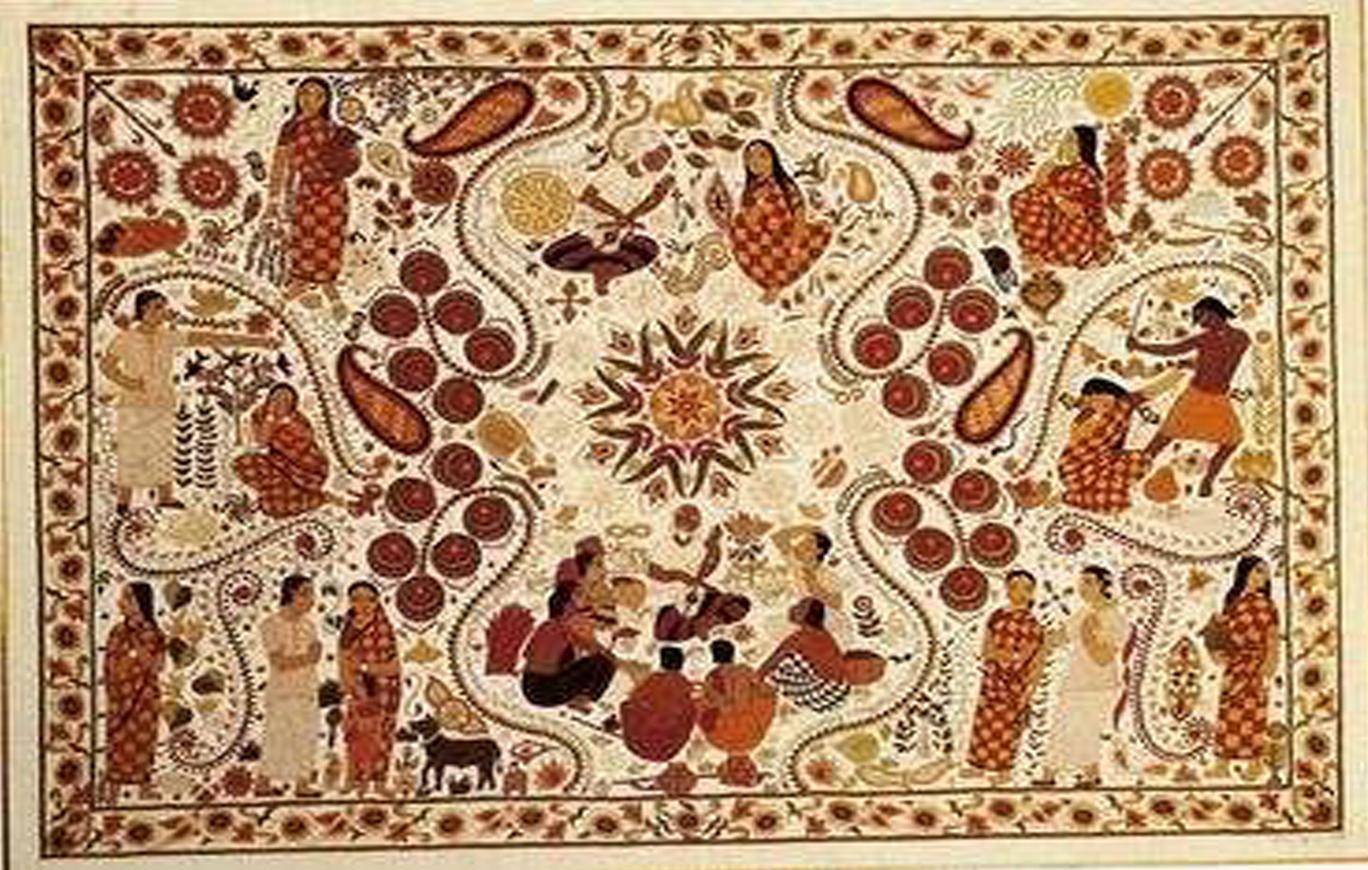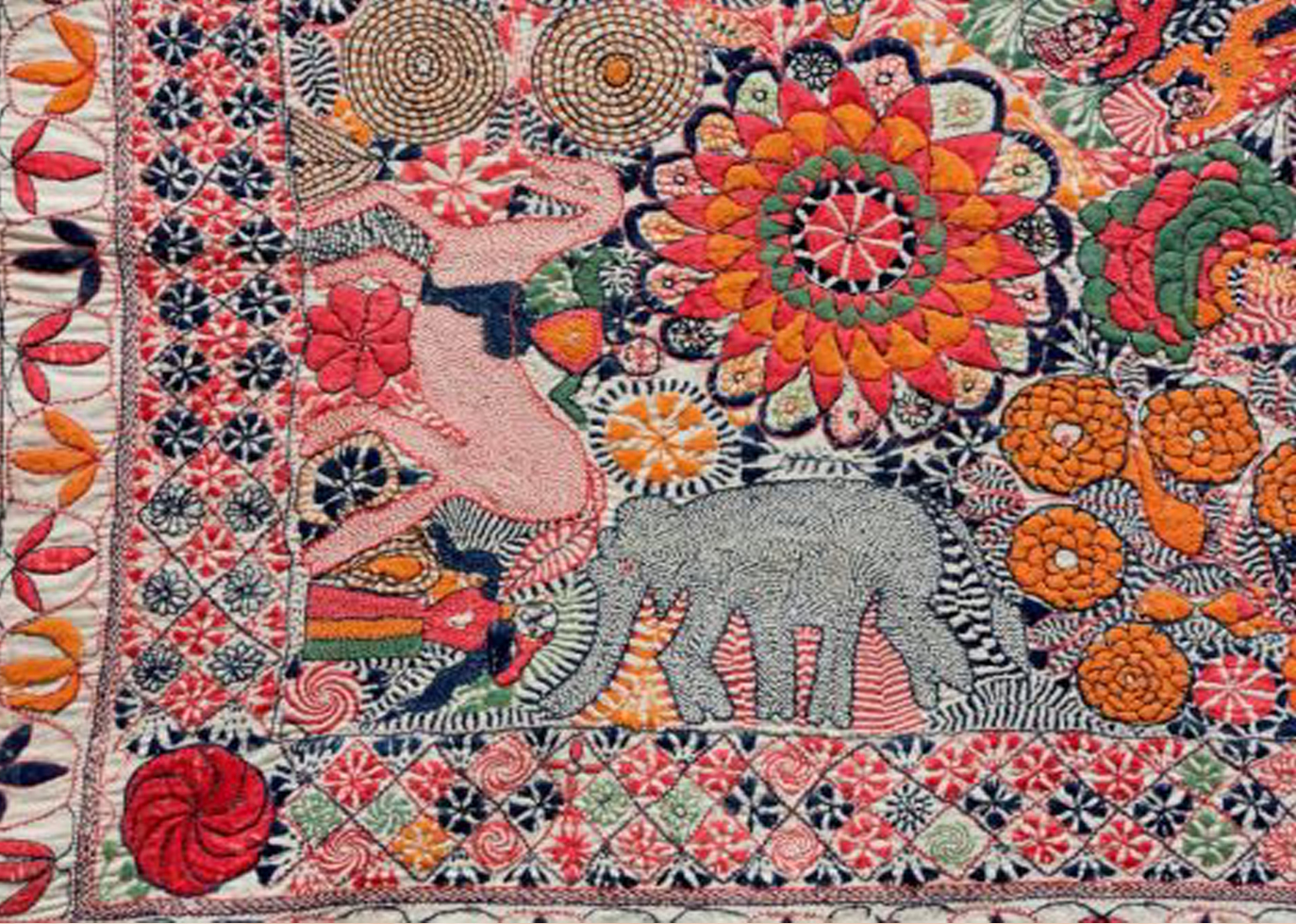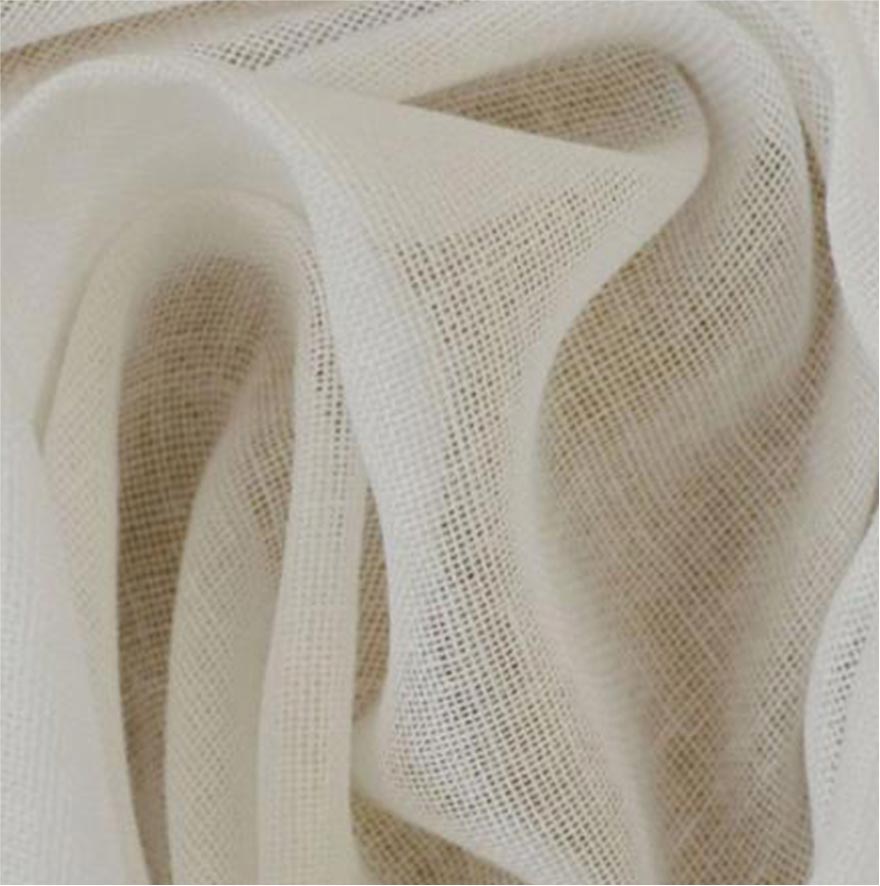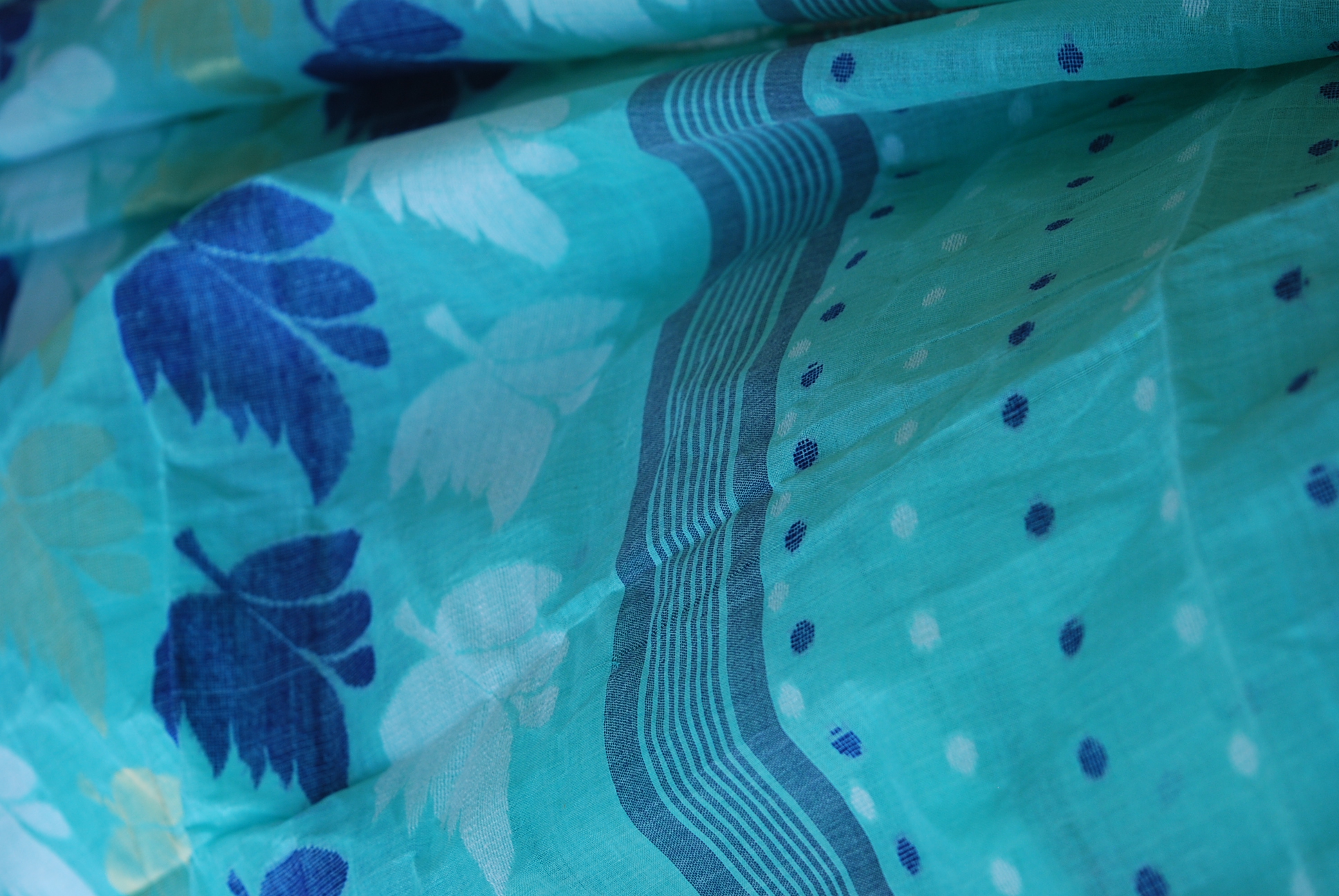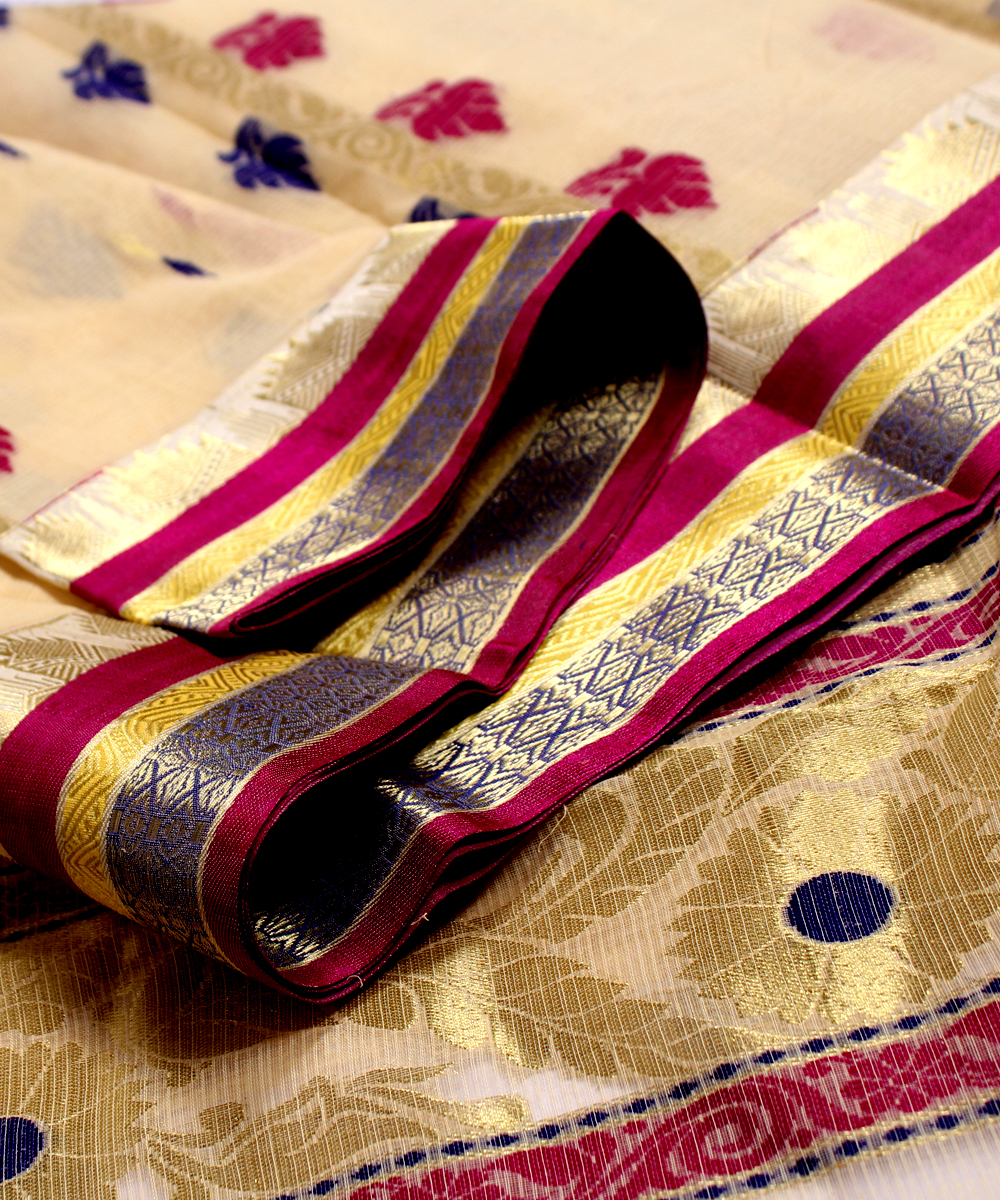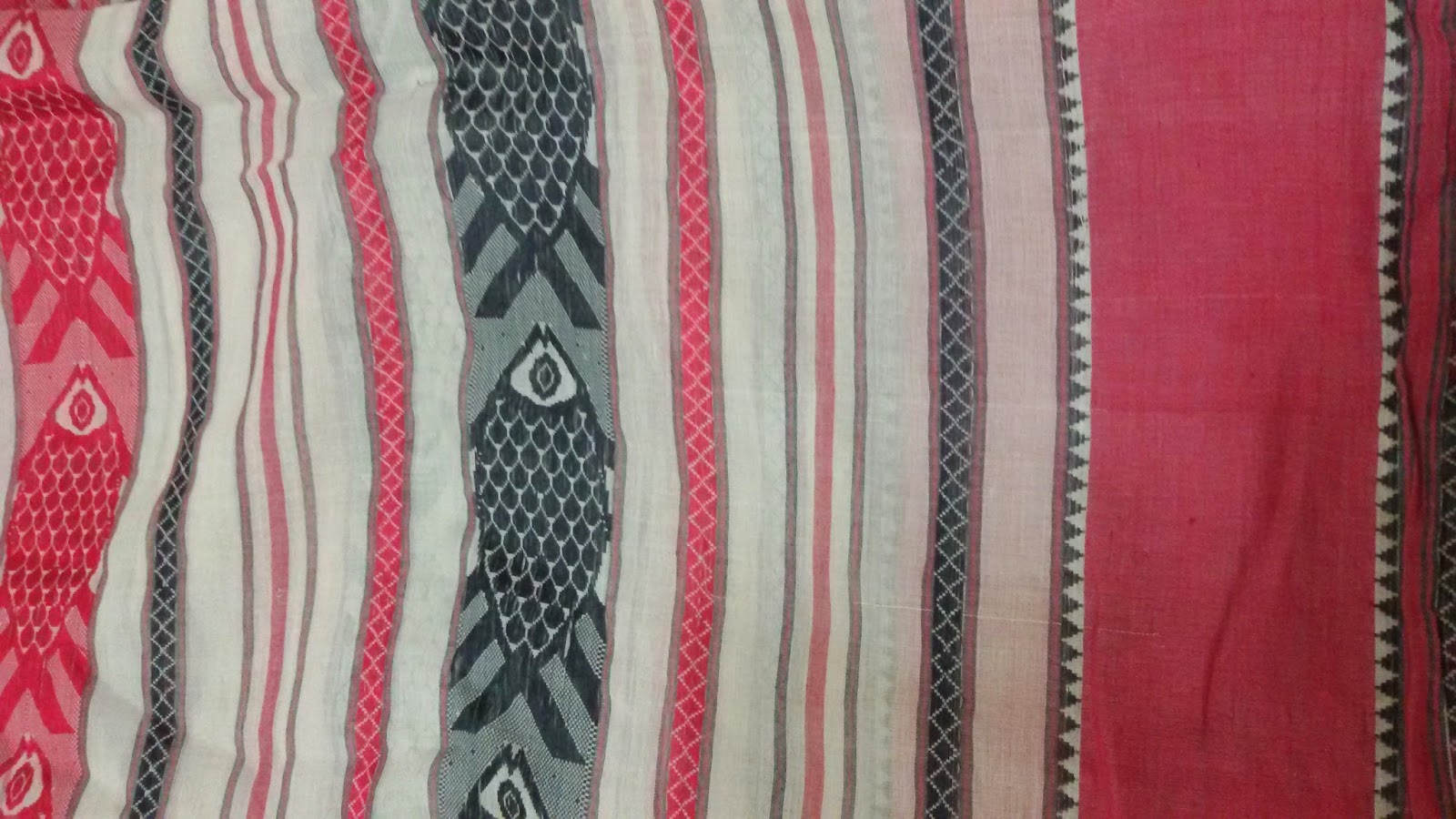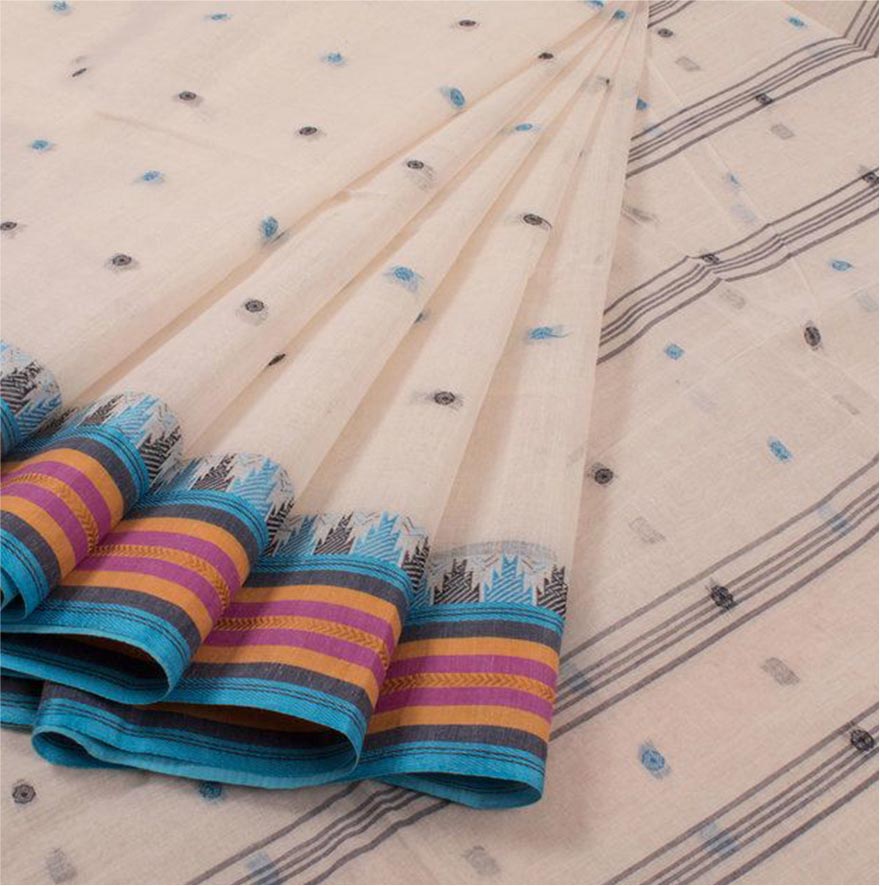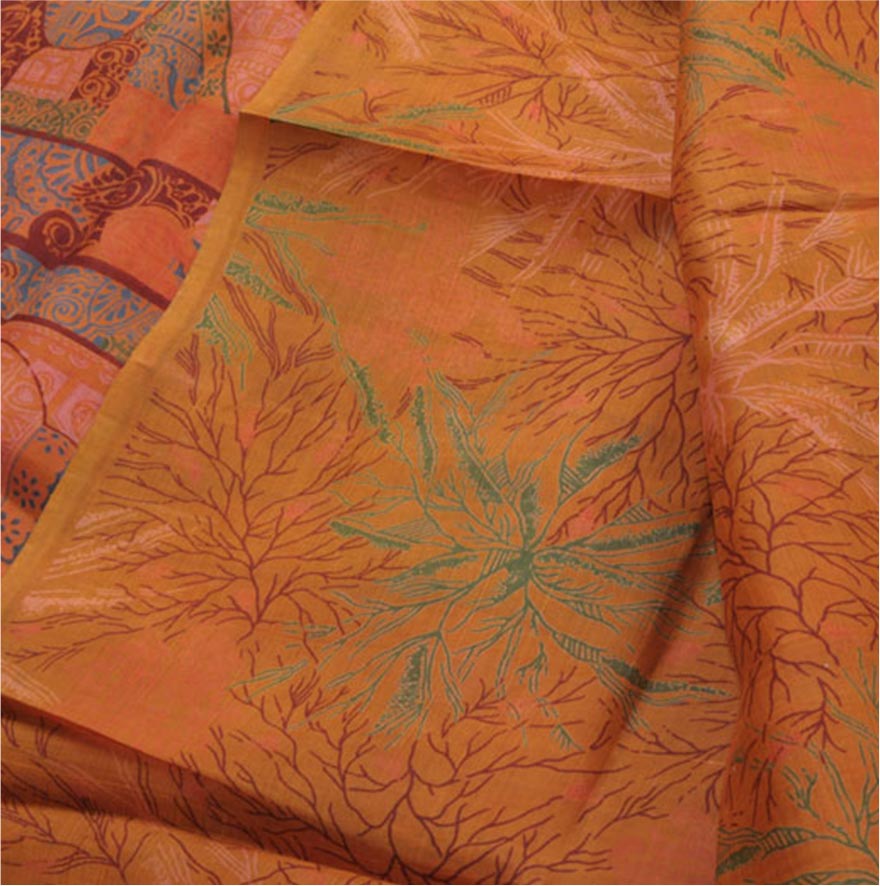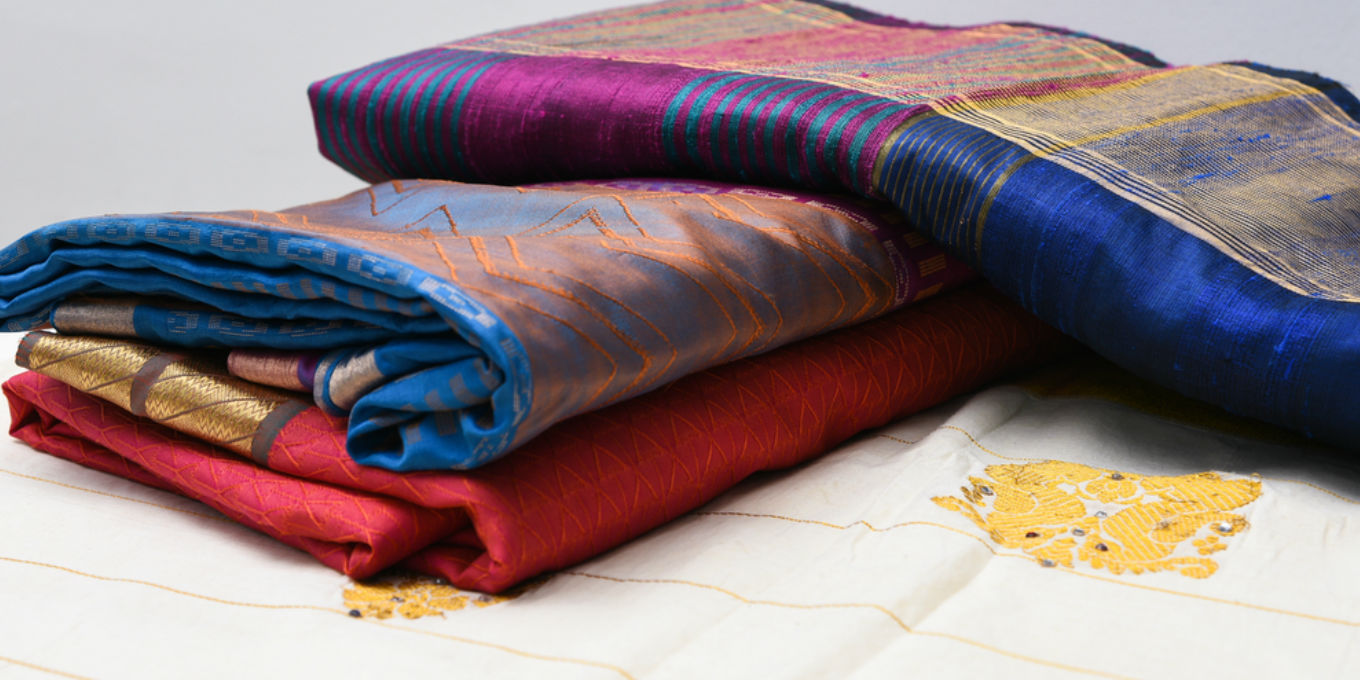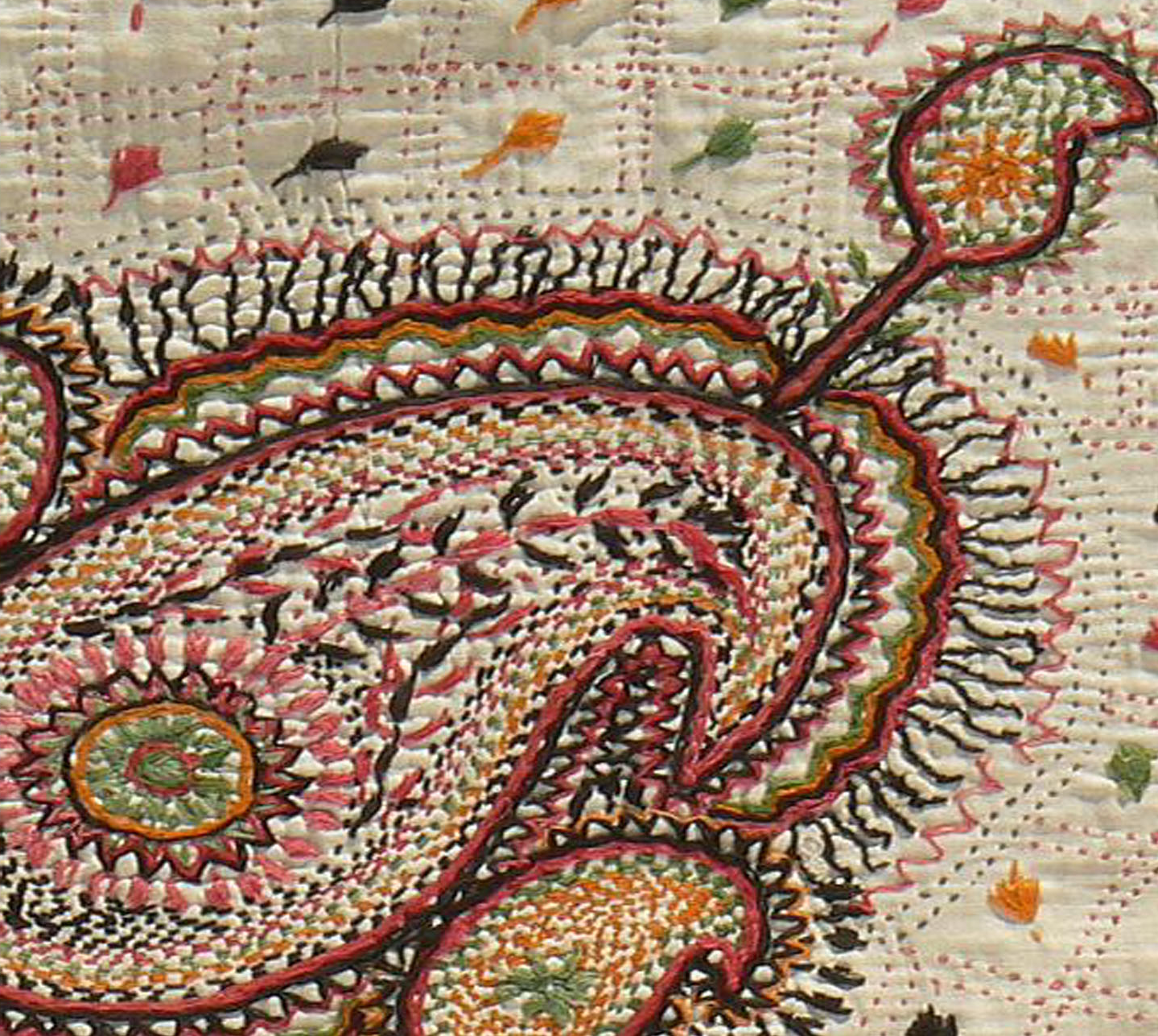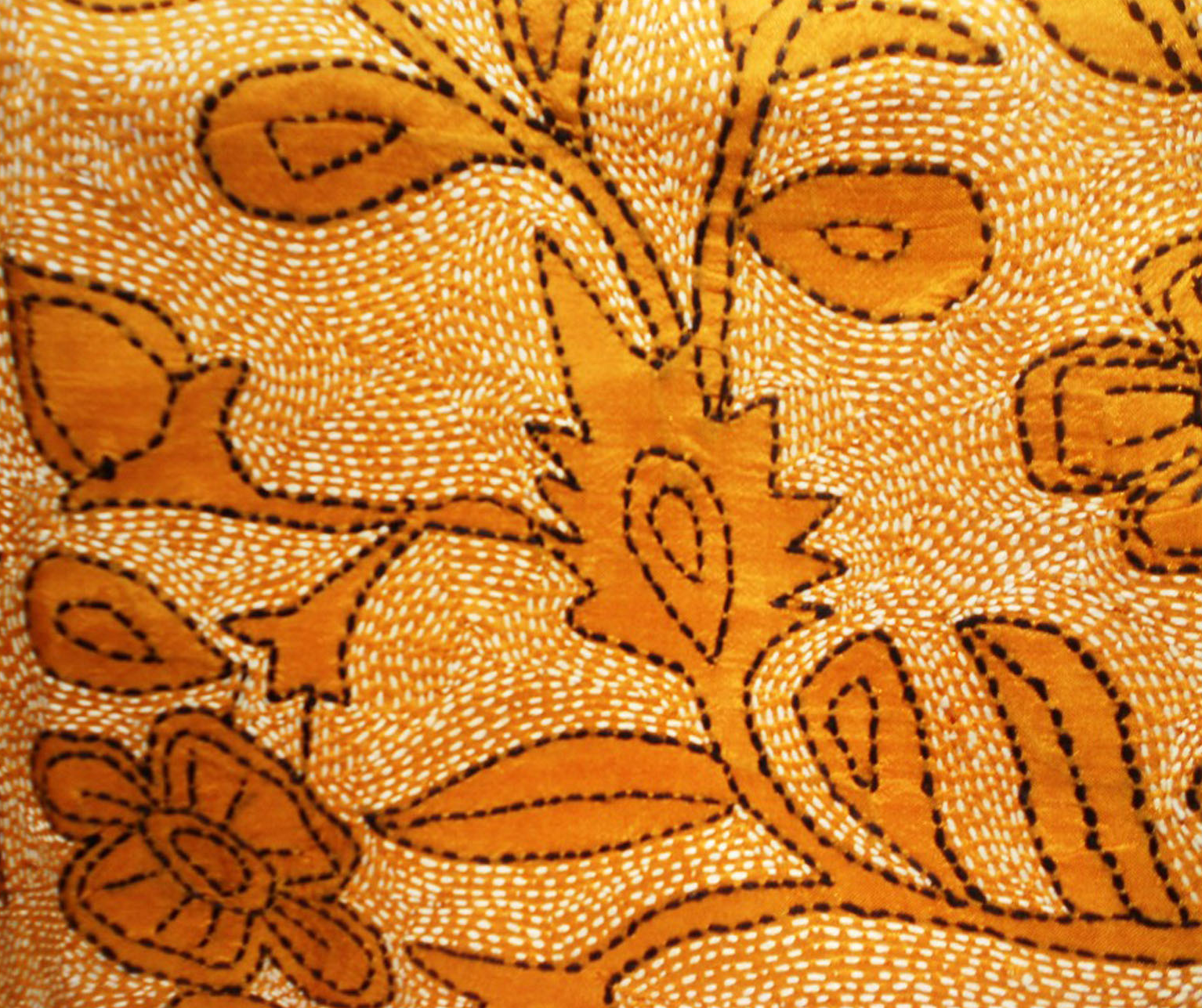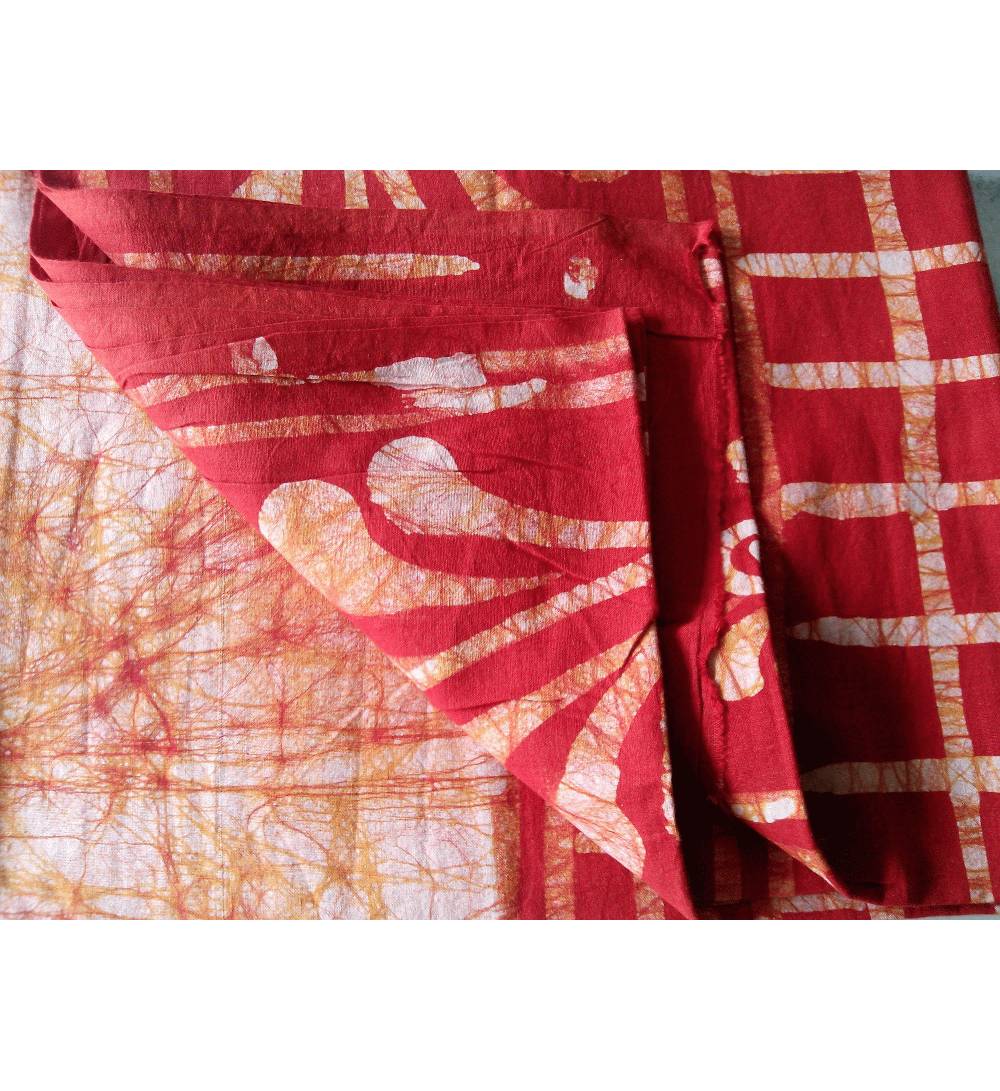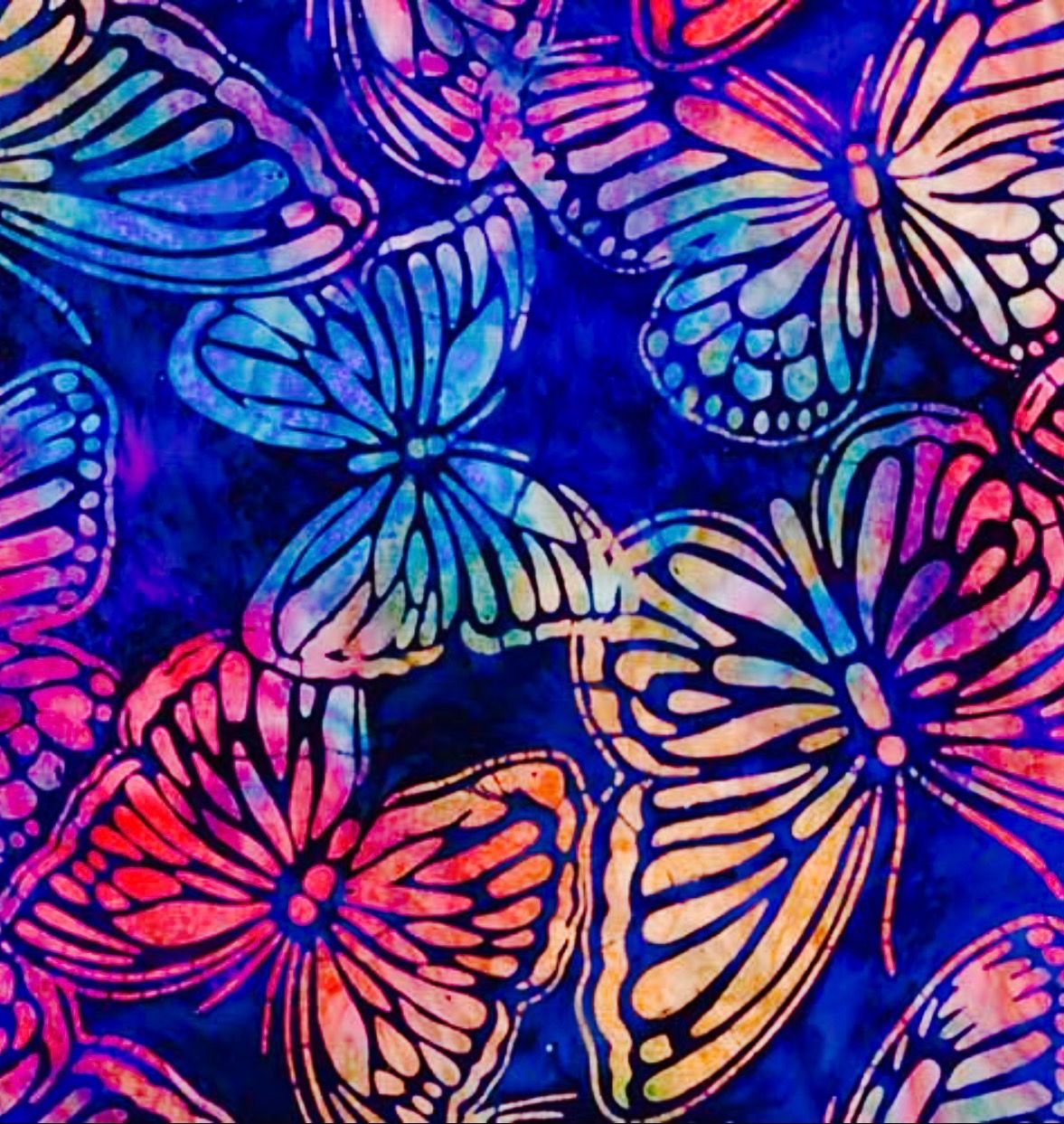Welcome,Please SelectYour Textile ofInterest
Baluchari
In the history of textile in Bengal, Baluchari or Baluchuri came much after muslin. Two hundred years ago Baluchari was used to be practiced in a small village called Baluchar in Murshidabad district, from where it got the name Baluchari. In the eighteenth century, Murshidkuli Khan, Nawab of Bengal patronized its rich weaving tradition and brought the craft of making this sari from Dhaka to the Baluchar village in Murshidabad and encouraged the industry to flourish.
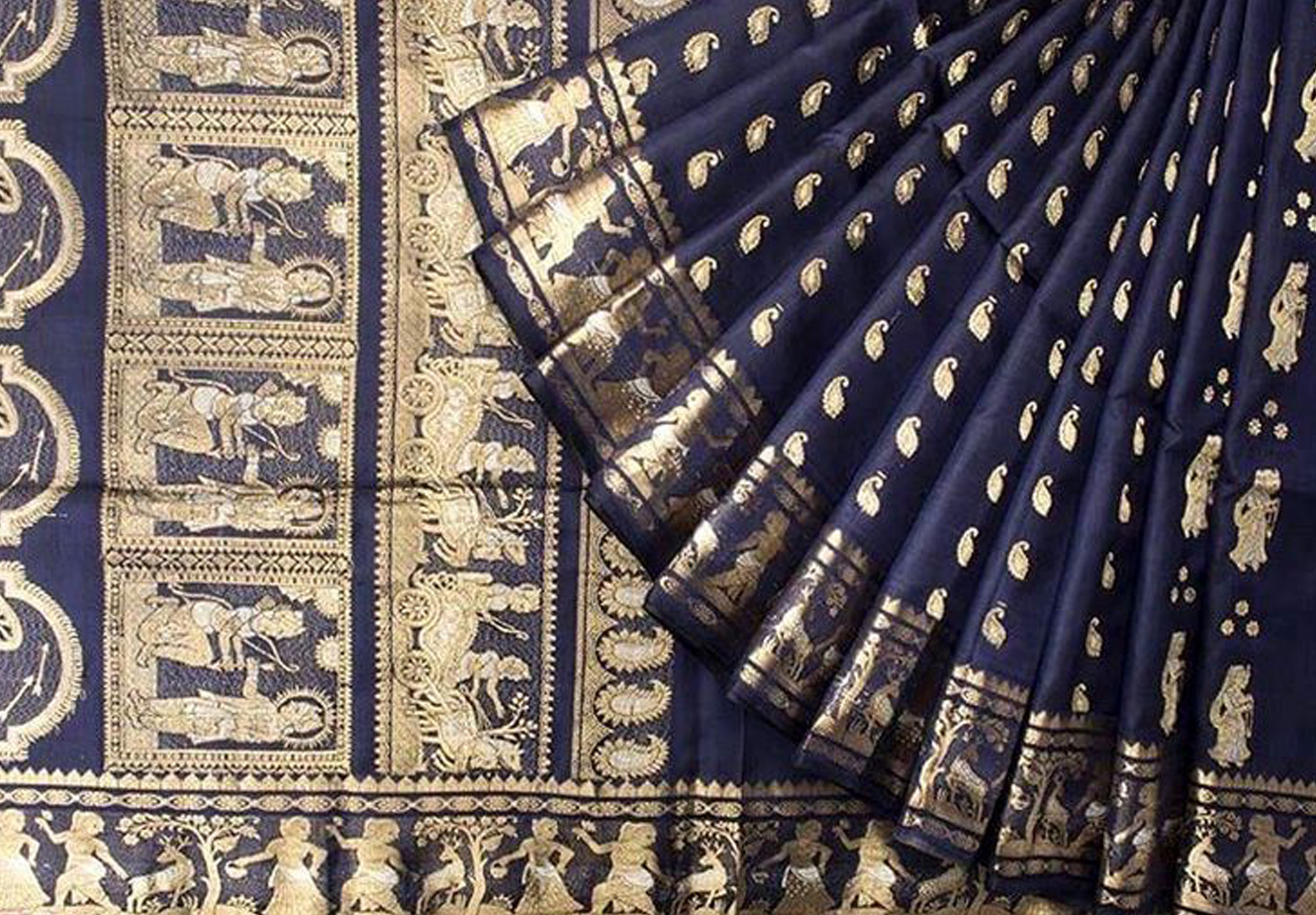
The Baluchari sarees are known for their intricate designs and handwork on them. No other saree uses as many mythological designs as the Baluchari sarees. They are dominated by stories and characters from epics like Ramayana and Mahabharata. Manufacturing a Baluchari sari is a time consuming process. It requires extremely good craftsmanship and takes around a week to weave one saree. These are hand woven and use the purest of yarns depending on the material,to make the yarn soft, it is boiled in a solution of soda and soap and then dyed in acid colour, also the silk yarn used for Baluchar saris is not twisted and so has a soft and heavy texture. Limited ground colours are used which are permanent in nature and retain their freshness even after many years.
Jamdani Dhakai
The word ‘jamdani’ is believed to be of Persian origin, derived from ‘Jam’ (meaning flower) and ‘Dani’ (meaning vase).
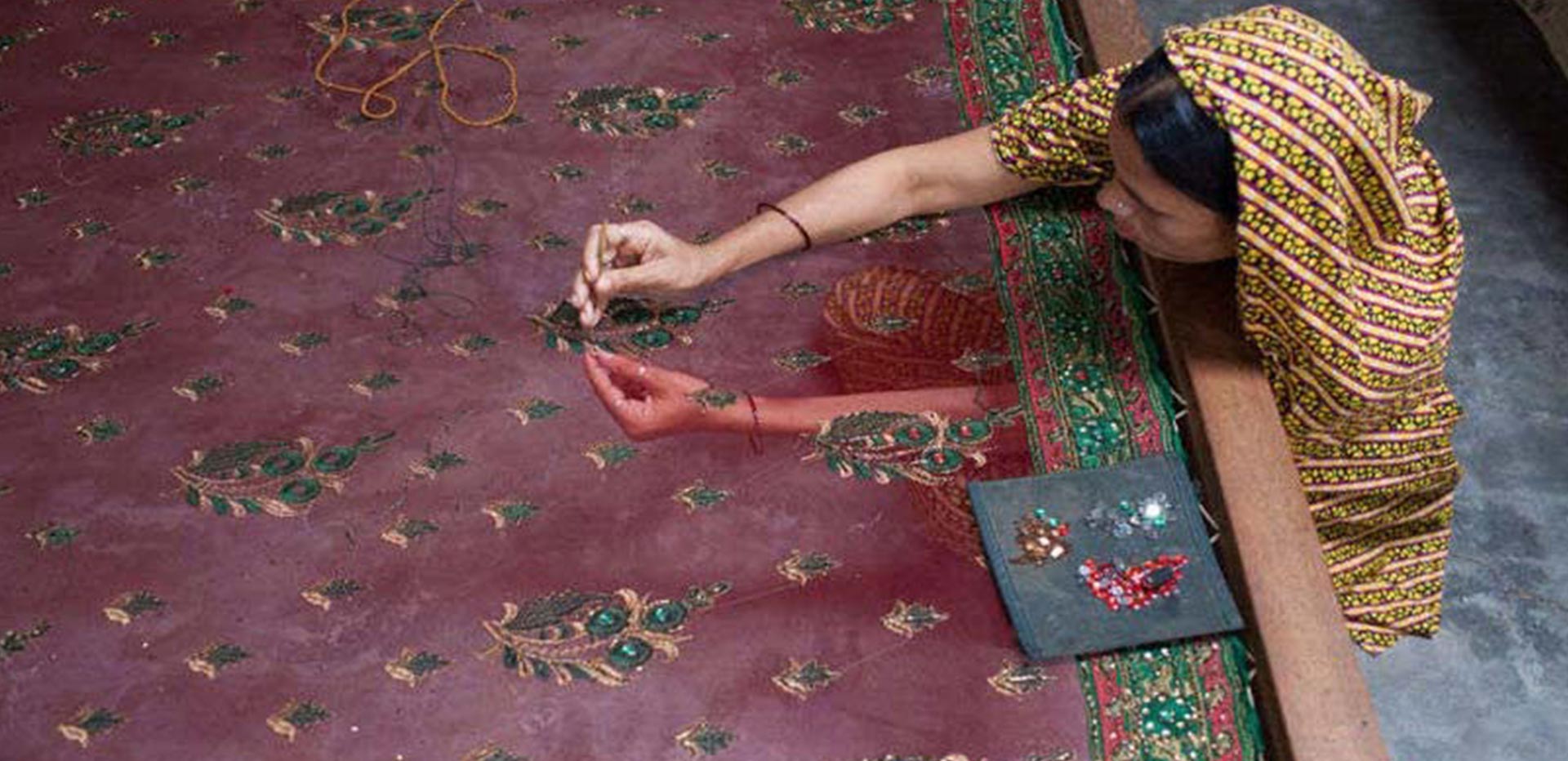
While there is some mention of this term in the literature from the 3 rd century BC (in Kautilya’s ‘Arthasharshtra Gupta Period’) and during the Guptaperiod (4 th – 6 th century AD), it is during the Mughal rule (16 th - 18 th centuries) that the weavers of Dhaka (in present day Bangladesh) who had been weaving this fabric for centuries, received extensive royal patronage. The finest varieties of muslin fabric were produced during this period with fabulous floral and figured motifs. Over the last few decades, the art of jamdani weaving has witnessed a revival due to support from the governments and non-government organizations in both India and Bangladesh.Jamdanis are mostly woven in lightly dyed backgrounds with designs in white, maroon, black, green, gold, silver and in muga silk of a golden colour.
Nakshi Kantha
A type of embroidered quilt, is a centuries-old Bengali art tradition in Bangladesh.The basic material used is thread and old cloth. Kanthas are made throughout Bangladesh, but the greater Mymensingh Rajshahi, Faridpur and Jessore areas are most famous for this craft.
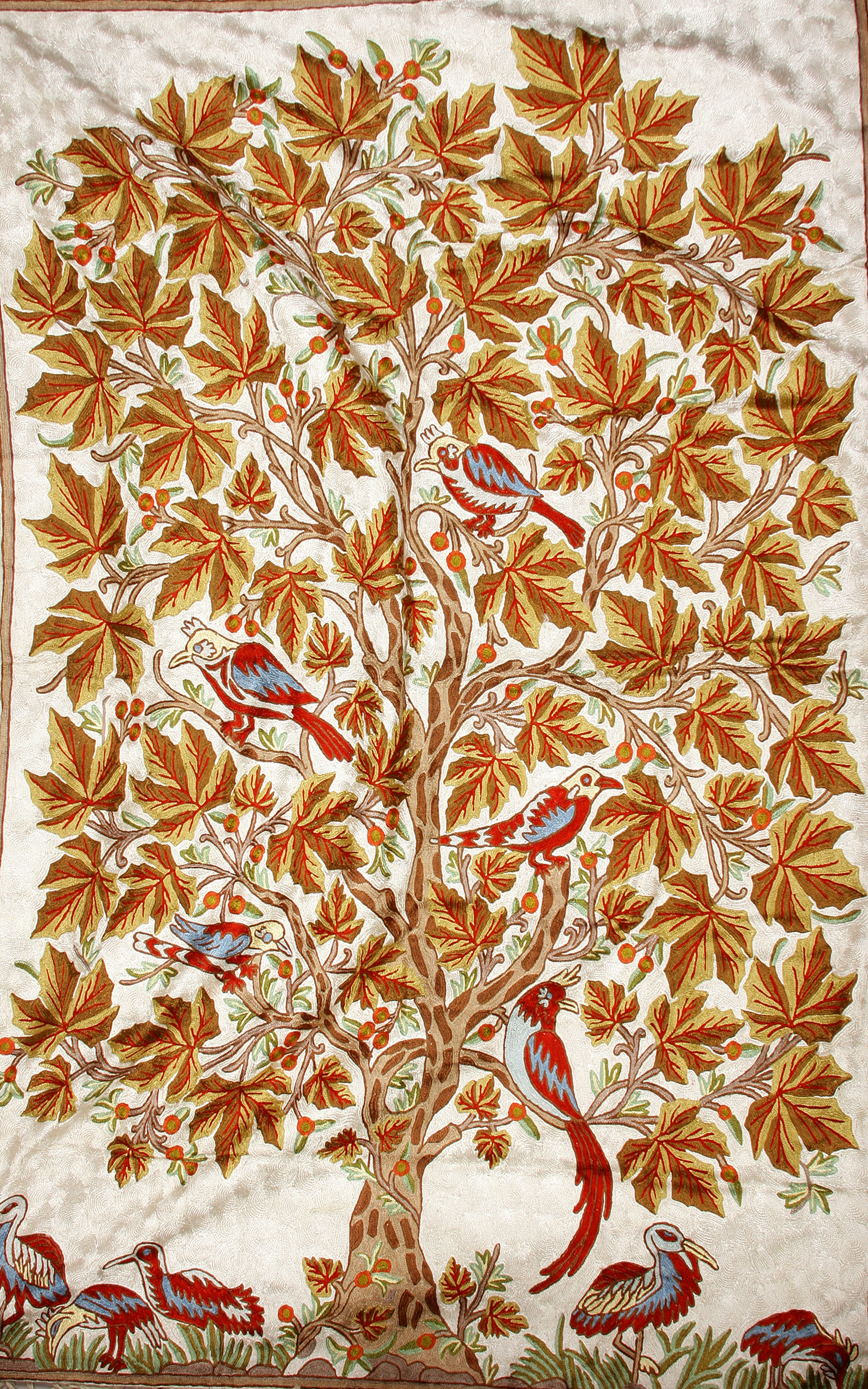
The colourful patterns and designs that are embroidered resulted in the name ‘Nakshi Kantha’, which was derived from the Bengali word ‘naksha’ which refers to artistic patterns. The early kanthas had a white background accented with red, blue and black embroidery; later yellow, green, pink and other colours were also included. The running stitch called “kantha stitch” is the main stitch used for the purpose.Traditionally, kantha was produced for the use of the family. Today, after the revival of the nakshi kantha, they are produced commercially. Originally, designs and motifs were not drawn on the cloth. The design was first outlined with needle and thread, followed by focal points, and then the filling of motifs were done. In a kantha with a predominant central motif the centre was done first, followed by corner designs and the other details. In some types of kanthas (carpet, lik and sujni, etc.) wooden blocks were used to print the outline. The blocks are replaced today by patterns drawn in tracing papers.
Muslin
In the history of textiles, there is no name more famous than that of Bengal Muslin. It is a finely woven light cotton fabric in plain weave without a pattern. Though it is said that the word 'Muslin' was derived from the name of the city of its origin, Mosul in Iraq. An Arab merchant named Sulaiman in the 9th century AD makes note of the material's origin in Bengal. The weave was so fine that Pliny, the famous Roman historian refers to one type of Indian muslin known as Jhuna, worn by Roman women of high rank.
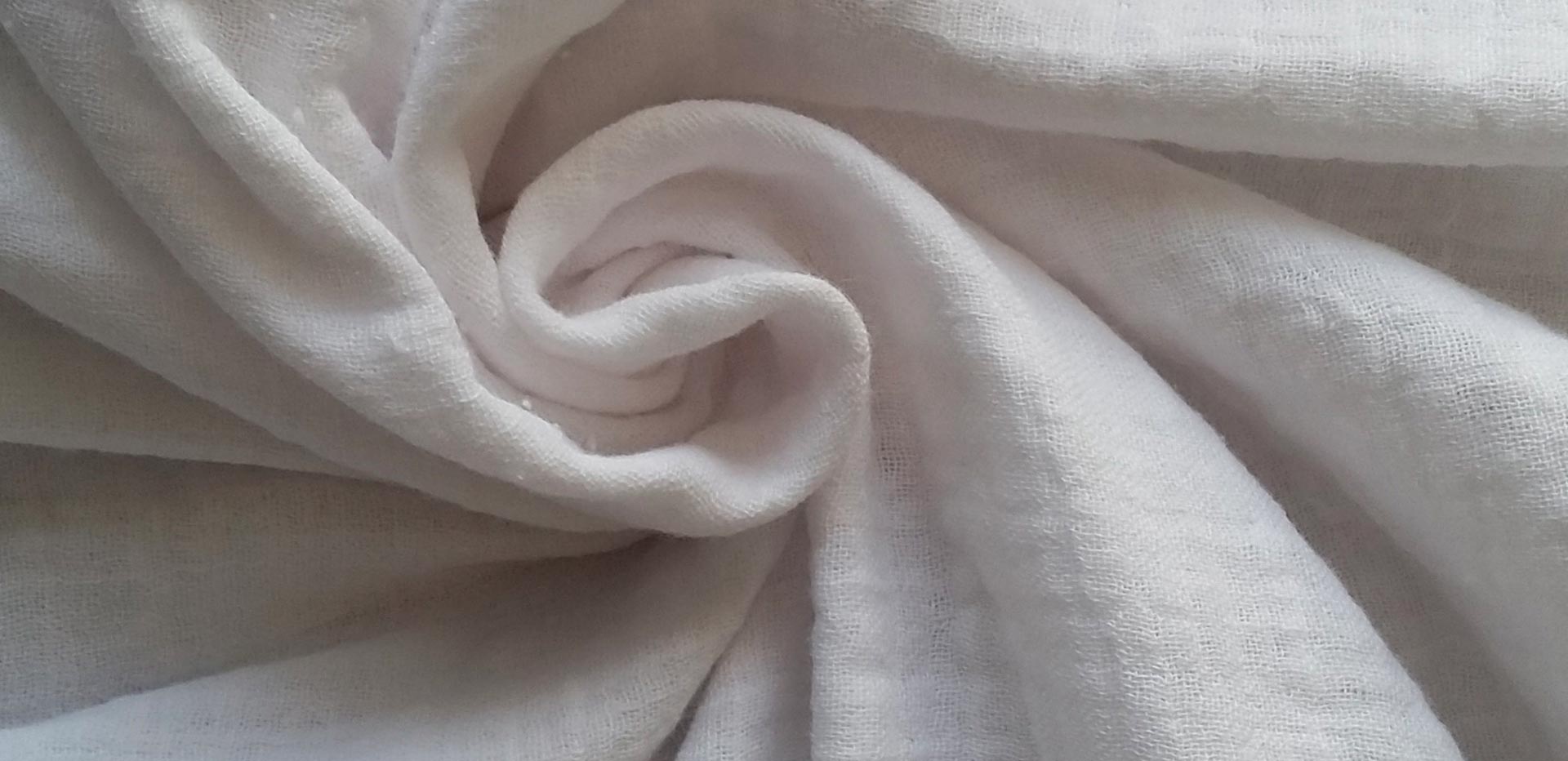
West Bengal produces nearly 55% of the Muslin produced in India. Though big efforts were made to revive the fine muslin that was known worldwide, it has so far been possible to create only the 500 count muslin. The entire process of spinning and weaving needs immense skill and patience, and only a very small quantity of the 500 count is produced in some areas of West Bengal. Cotton khadi yarn beyond 100 threads is considered to be Muslin Khadi which can be produced up to 500 count or more. In West Bengal, there are primarily seven districts, which can be identified as major pockets of muslin fabric. Murshidabad, Birbhum, Nadia, Burdwan, Malda and Hooghly and Pascim Medinipur. There are around 900 to 1100 families engaged in muslin production. More importantly even though muslin in produce in some countries of West Asia, their artisans can hardly go beyond 200 count. It is only these six districts that yarns of 500 counts and more are produced. Such fine yarns are of high demand in the International market, especially in Japan.
Tangail
There is a key difference in the weaving technique of extra weft designing between jamdanis and tangails ; the embroidery thread in jamdani is inserted after every ground pick whereas in tangails the embroidery thread is inserted after two ground picks.
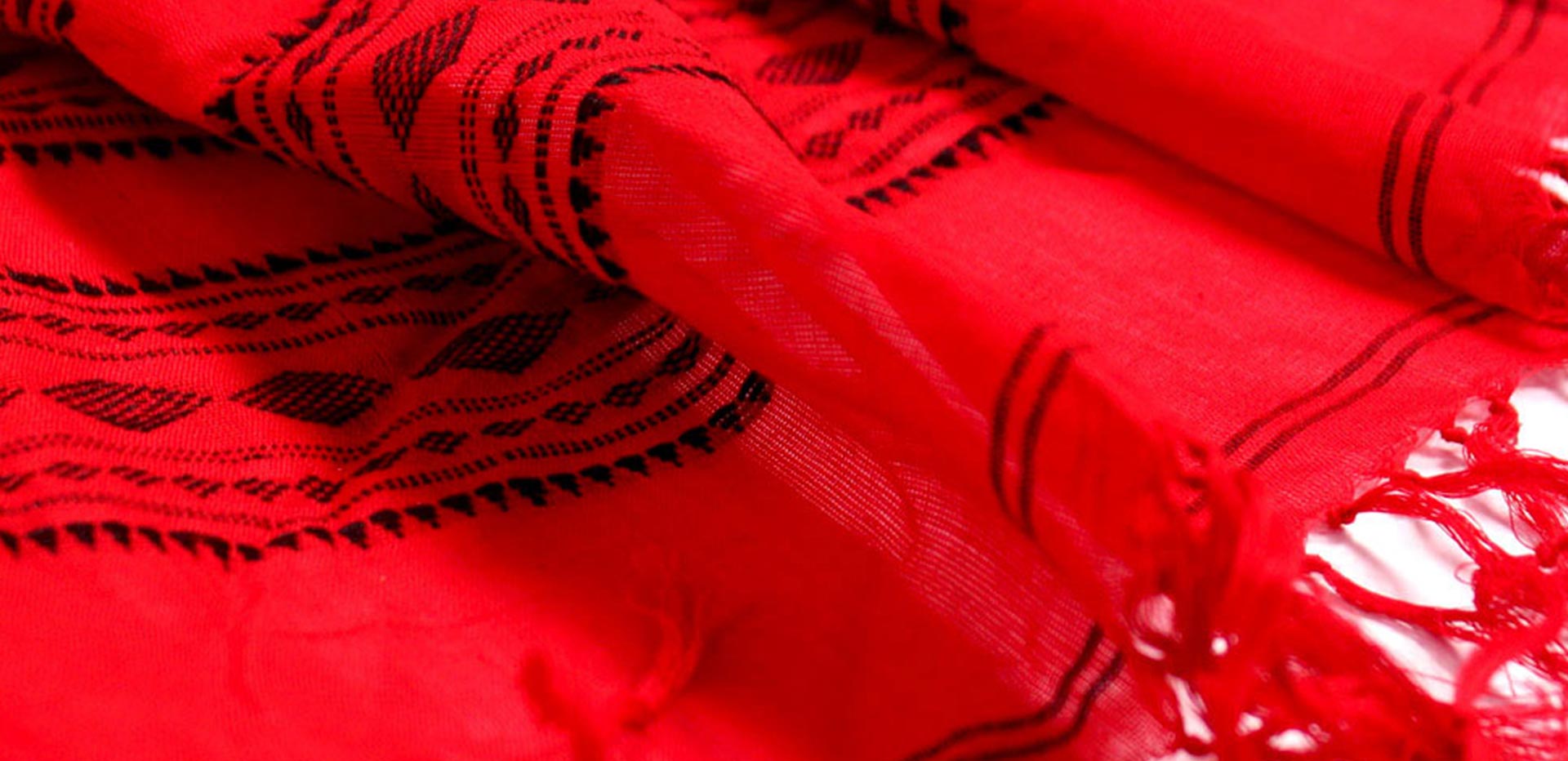
The main characteristic of tangails is the extra weft butis, tiny motifs repeated all over the ground. Traditionally jamdanis are woven in white with designs in bleached white. Traditional jamdani saris with geometrical designs and cotton tangails are very popular and continue to be woven by weavers originally from Bangladesh.
There is a rich tradition of weaving handloom cotton textiles among the tribal and semi-tribal people n the districts of West Dinajpur, Jalpaiguri, Maldah, and Cooch Behar in North Bengal.
Dhaniakhali
The exact time of origin of this handloom manufacturing centre is very difficult to find out because of scarcity of reliable data, but it can be said that in the years of 1933-1938 some clothes ( a kind of “Chadar”) were being produced using silk as a raw material, this “Shushi” Chadar was so fine in texture that it was compared to the famous “Dhakai Muslin” silk.
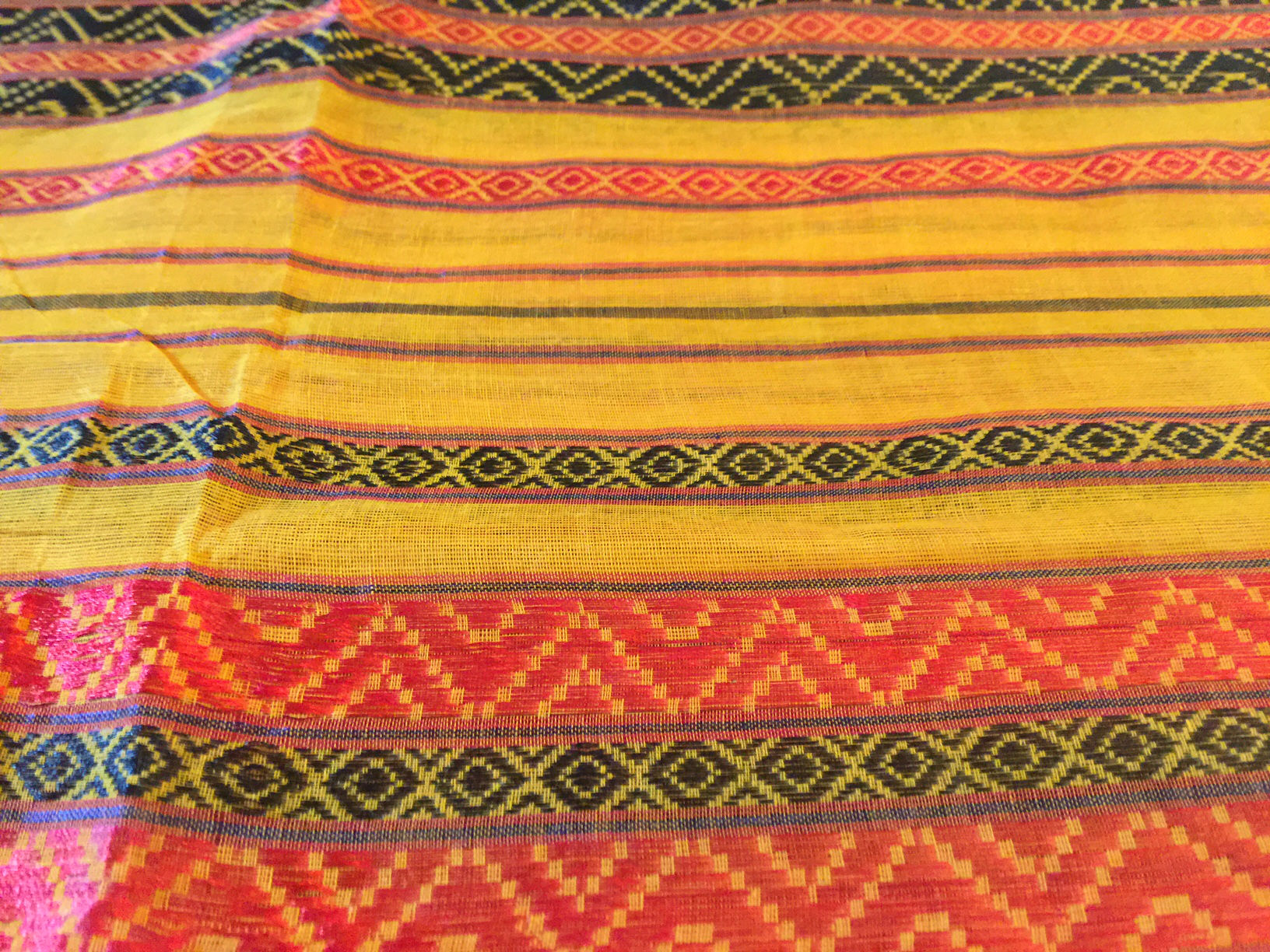
Then Dhotis and Sarees were being produced using both the cotton and silk yarn, this cotton yarn was mainly imported from abroad. Traditionally, the ground of a Dhaniakhali saree was in Kora or natural grey with either red or black plain border. Dyed yarn was first introduced in 1942. “Dhaniakhali tant” is one of the most famous name in the handloom field of West Bengal and due to its coarse texture, but the surprising fact is that though there is enough demand the productivity and also the number of weavers is decreasing day by day. According to Tarun Var, ( surveyed weaver of Dhaniakhali) 40- 50 years ago a weaver earned double than a teacher or govt. employee but the situation has completely changed at the present time.
Garad
Garad (also known as Garod) silk is one of the popular styles of saree that has its origin in West Bengal. Also known as Gorod, the word Garad means ‘White’. Garad silk sarees are distinguished by its red border and small paisley motifs.

Silk fabric used to weave Garad sarees is not dyed which keeps the purity factor of the fabric intact and therefore these sarees have a sacred importance to the women in Bengal. The Murshidabad district of West Bengal specializes in weaving these Sarees wherein the silk yarns are woven close together which imparts the fine texture to the sarees.
Murshidabad Silk
The Murshidabad district of West Bengal is well-known for producing silk of excellent quality. The history of silk weaving in this region goes back to the early eighteenth century during the Mughal rule in India, when the Nawab of Bengal, Murshidkuli Khan, shifted his capital from Dhaka (in present day Bangladesh) to a town on the east of the Bhagirathi river, and named it Murshidabad after him.
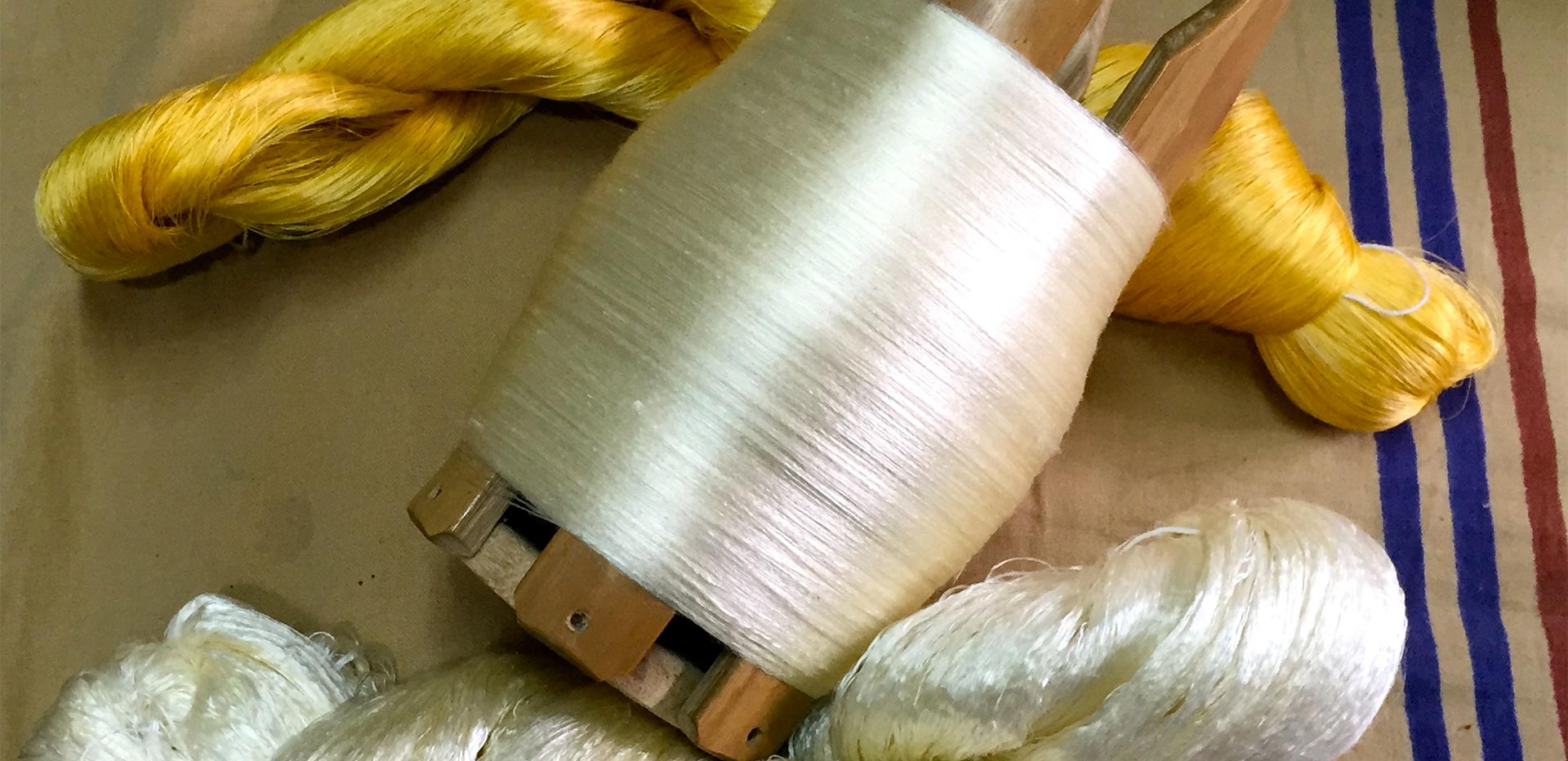
The silk industry of Murshidabad district, is considered to be next agricultural products having 62% of the silk handlooms in West Bengal and providing employment to at least 100000 people. Today, Murshidabad continues to be home to some of the important silk weaving clusters in the state producing fine silk sarees, shirts and plain silk fabric.
There is a huge demand for Murshidabad silk sarees. The Gankar Mirzapur Coriel or high quality Garad saree is especially renowned. Sarees produced at Jiagang enjoyed global popularity. West Bengal is the 3rd largest producer of silk among all Indian States.
Kantha
Kantha embroidery derives its name from the same word with two different meanings.
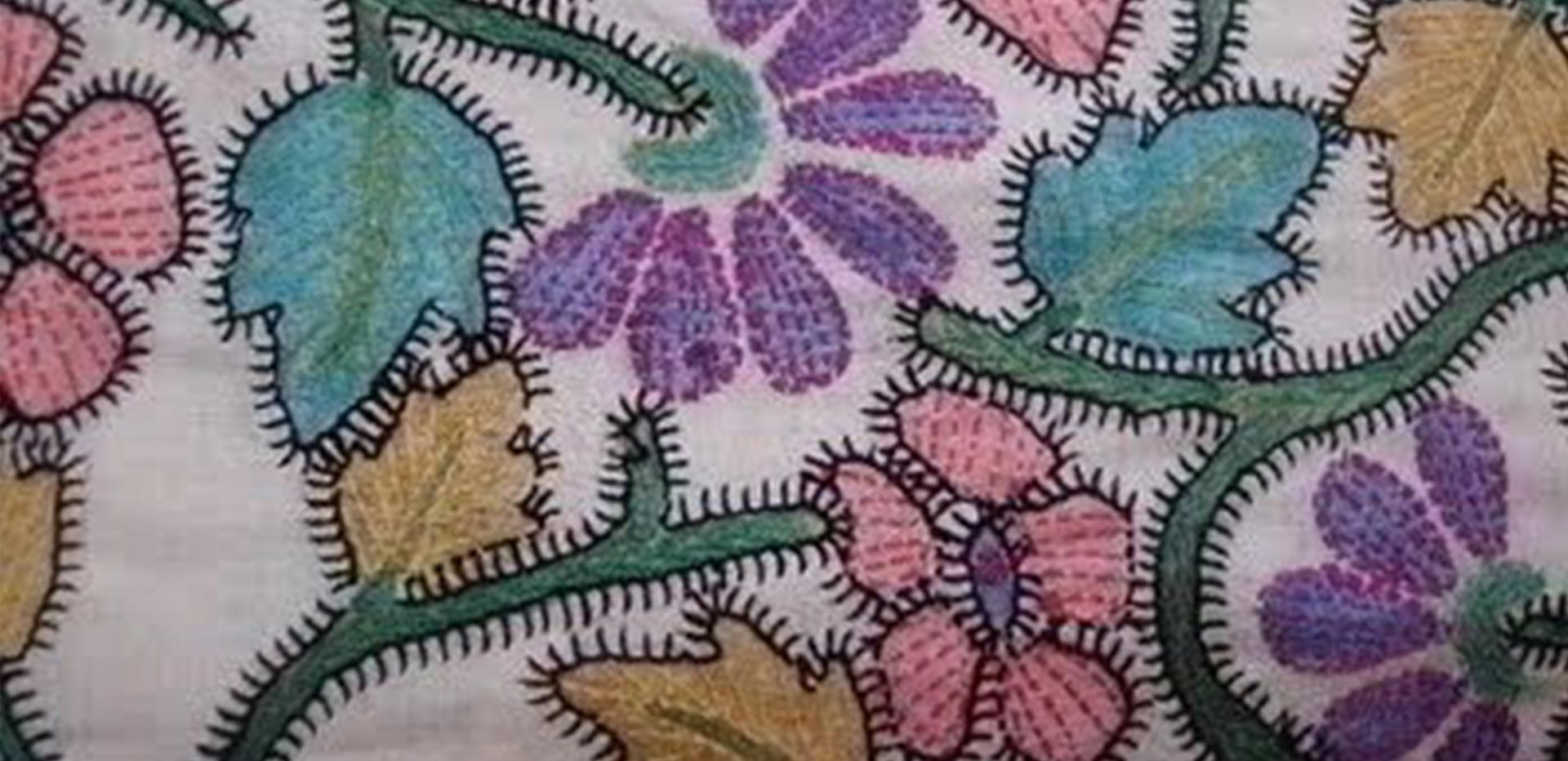
‘Kantha’ means ‘ rags’ in Sanskrit, which reflects the fact that Kantha embroidery is made up of discarded garments or cloths.
Kantha is one of the oldest forms of embroidery that originated in India. Its origin can be traced back to ancient pre Vedic ages. Motifs found in early Kantha embroidery include many symbols that were derived from ancient art. These symbols depict or are reflective of nature, such as the sun, the tree of life and the universe. It was not until later that Kantha embroidery was used as a medium of cultural and religious significance, which came about as a result of Hinduism’s influence and was used in ceremonies and pujas, including celebrating weddings and births.
Begampuri
Begampuri, in the Hooghly district of West Bengal, is not far from Kolkata but as your car drives slowly through narrow alleys, and besides small pukurs (ponds), it is a world, miles away from the bustling city.

Children all in neatly pressed school uniforms, ride in a single file on their bicycles. A little village wedding band plays to its own tune as it winds through the village. As you enter the Begampuri Handloom cluster, you can see cotton yarn being dyed red and green in the rich colours that their sarees are so famous for, and the handlooms keeping up their gentle clacking giving rhythm to the village life.
Begampuri sarees are beautifully handwoven, easy to maintain cotton saree that do not require frequent starching and drape like a dream. Once very famous for its distinctive weave, this is now being revived through a cluster development initiative by the Government of West Bengal- better in quality, colour fast, with finer yarn, one with all the design tradition of the classical Begampuri sarees, but with a completely wearable, contemporary feel..
Batik
Batik is a method of producing designs by using waxing and dying techniques. Batik is used in making shirts, sarongs, skirts, dresses and almost any other item of clothing in many parts of the world.
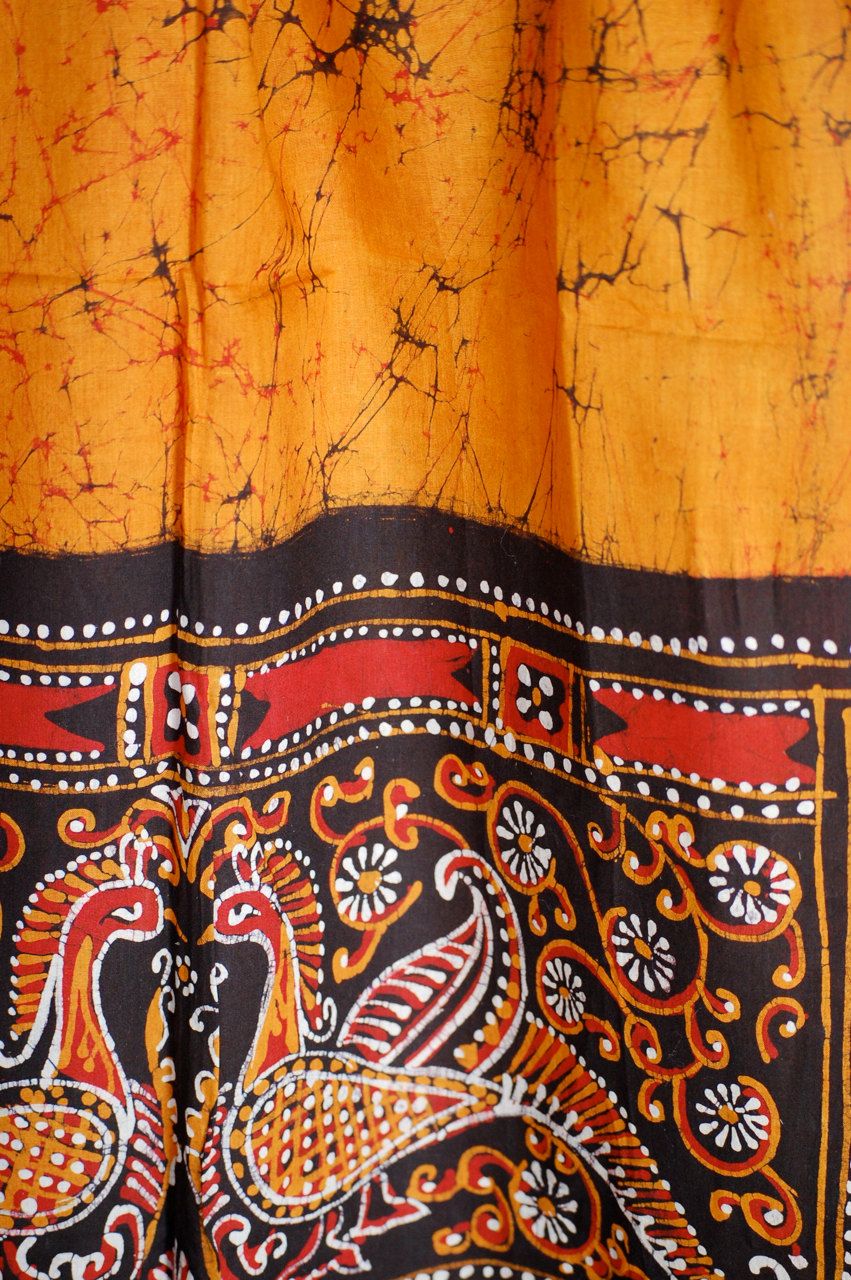
Batik is an old Javanese word that means “to dot” or "to stipple". The word batik is thought to be derived from the word 'ambatik' which translated means 'a cloth with little dots'. The suffix 'tik' means little dot, drop, point or to make dots. Batik may also originate from the Javanese word 'tritik' which describes a resist process for dying where the patterns are reserved on the textiles by tying and sewing areas prior to dying, similar to tie dye techniques. Another Javanese phase for the mystical experience of making batik is “mbatik manah” which means “drawing a batik design on the heart”.
Batik designs are made by covering part of the fabric with wax or another dye-resistant material such as rice paste and then dying it and then boiling it to melt the wax away. Dye doesn't penetrate the wax, which is then scraped or melted away, leaving behind a design, repeated waxwings and dyings produces intricate multicolored designs.
Patterns drawn with a wax-filled pen known as a canting are called batik tulis. Using this methods the design is traced onto a prepared white cloth or onto a clothe that has already been dyed. the pattern is then drawn with wax. Wax is kept on areas already with dye to protect them from more dye. The process s often repeated with progressively darker shades until the desired motifs and colors are produced.
Hand blocked batiks, in which the wax is applied with a copper stamp, are called batik cap. items made using this method often have the same images repeated several times.
The Batik technique is extensively practiced for sarees and dress materials in Shantiniketan(Bolpur district) and the Sunderbans villages of West Bengal.

